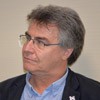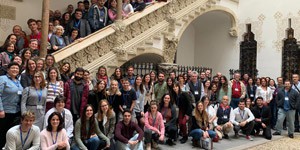By Julián Romero

Julián Romero holds a PhD in Pharmacy (1997) from the Complutense University of Madrid and is currently the Academic Director of the Degree in Pharmacy at Francisco de Vitoria University (Madrid). Throughout his professional career, Dr Romero has worked in Spanish and international centres such as the University of Cantabria, Brown University (Providence, Rhode Island, USA) and the Wisconsin Medical College (Milwaukee, Wisconsin, USA). A scientific researcher at the Fundación Alcorcón University Hospital, he has published more than 70 articles in international journals related to cannabinoids and their therapeutic potential. He is the current President of the Spanish Cannabinoid Research Society, of which he is a founding member. His research group focuses its work on the possible use of endocannabinoids in Alzheimer's disease and maintains collaborations with groups and companies in Spain, Great Britain, the United States, Israel and Italy. He is also a member of the Journal of Neuroinflammation Editorial Board.
By Javier Fernández Ruiz

Javier Fernández Ruiz holds a PhD in Biology (1986) from the Complutense University of Madrid (UCM). He is currently a professor in the UCM's School of Medicine. He has been working as a researcher for the last 36 years and has written many research articles and chapters for books. He has filed 5 patents. He lectures in universities, research centres and at conferences. He is currently the principal investigator of the CANNABINOIDS-BBM3 research group of the University Institute of Research in Neurochemistry at the UCM, the CIBERNED, and the IRYCIS. The group's work centres on the study of the therapeutic potential of cannabinoids in various neurodegenerative diseases. It collaborates with several Spanish and international groups. Dr Fernández Ruiz has been principal investigator on 26 research projects. He was the president of the "International Cannabinoid Research Society (ICRS)" from 2002-2003 and was a founding member of the Spanish Cannabinoid Research Society (SEIC), of which he has been the Secretary (2000-2007) and President (2007-2011). He currently sits on the governing board of the IRYCIS, the scientific advisory board of the company VivaCell Biotechnology Spain and the editorial committee of the British Journal of Pharmacology.
It seems evident over the years that cannabinoid research in Spain has acquired a high degree of maturity and relevance around the world. The references to Spain always highlight the importance in many areas, especially those related to research into cannabinoid therapies for pathologies such as cancer, neurodegenerative and psychiatric diseases and metabolic disorders. In an attempt to explain the background that has led to this point, this article is not intended to be a rigorous review but rather a recognition of the different milestones that have guided it over the years.
In the 1980s, research into cannabinoids in Spain, judging by the scientific publications compiled in PubMed, was almost exclusively psychiatric, associated with the consequences of recreational cannabis use. There was no indication at that time that years later cannabinoid research would take a huge turn, from considering these substances as a simple determinant of certain pathologies, to be considered as therapeutic tools for treating diseases including, paradoxically, different psychiatric disorders. The first scientific results were derived from research carried out with laboratory animals, but still linked to the idea of cannabis strictly as a drug of abuse, at the end of the 1980s and were aimed at determining the neurotoxicological effects of these derivatives when consumed during pregnancy or during breastfeeding. These effects were related to the so-called "cannabinoid receptors" described by Allyn Howlett in those years, assuming that the human brain, even during development, contains high levels of these receptors in neural cells, especially in neurons. The question was: To be activated by what molecules? Or put another way: Does the human brain have cannabinoids of endogenous origin? This challenge, perhaps one of the most important of "modern cannabinology", if phytocannabinoid identification is placed in the middle of the 20th century as the main challenge of the "first cannabinology", took little time to be deciphered. The year 1992 ended with news of the isolation of the first endocannabinoid, the "anandamida", by Dr Mechoulam's group in Jerusalem. A short time later, the same group and that of Dr Sugiura in Japan identified the second endocannabinoid, 2-arachidonoylglycerol. These facts marked a before and after in cannabinoid research, since they confirmed something that was already vox populi in this field: that these receptors, far from being simple targets for cannabinoids present in a plant, are part of a new system of regulation in the brain, which is known to also be active on cardiovascular tone, the immune system and liver function, among others. Interestingly, the endogenous ligands active on these receptors are lipids. In the brain, endocannabinoids and cannabinoid receptors control the correct functioning of neuronal synapses, allowing both to participate in regulating numerous functional processes such as memory, movement, nociception, brain reward, emesis and appetite, to name a few. This path, that of identifying a brain's system based on simple research into the action mechanisms of substances with pharmacological properties, is not new to research. It is the same story that occurred in the 1970s with morphine and other opiates, which enabled the discovery of the endogenous opioid system, and benzodiazepines, which enabled allosteric regulation sites in a GABAergic system receptor to be identified.
For these reasons, many researchers in Spain and abroad turned their eyes towards studying the endocannabinoid system and decided to focus their efforts on it. This was especially relevant in the case of research groups from the opioid and lipid area. The International Cannabinoid Research Society (ICRS) conferences began to accommodate scientific communications that included these aspects. The first Spanish researchers who participated in the ICRS conferences did so at the dawn of this community, thus leaving evidence of the incipient but determined commitment to research in this field.
In 1994 there was a significant development in the progress of research into cannabinoids in Spain, such as Professor Raphael Mechoulam's visit to the country. This was the first of the many subsequent visits he made to Spain and in all of them it was confirmed that Raphael is a magnificent mentor of young researchers and an infallible support for the boldest proposals, and through which something has been learned that has incalculable value: that the greatest wisdom also implies great humility and bonhomie. That first meeting with Raphael was a definitive endorsement to cannabinoid research in Spain, resulting in, among other things, different international scientific meetings sponsored by the Ramón Areces Foundation (periodically since 1998) in which Spanish researchers could share their scientific results with leading international researchers in this field such as Roger Pertwee, Billy Martin, Allyn Howlett, Vincenzo Di Marzo and Beat Lutz, among others. Appreciating that good science was applied here in the field of cannabinoids contributed to another of the fundamental milestones in the country's history: the annual ICRS conference in El Escorial in July 2001. The participation of many Spanish researchers was stimulating and insightful effect for everyone, achieving an expansion of research into cannabinoids in Spain that really striking in the global context. From this time (and from the impulse it generated) contributions as relevant as the identification of the antitumor properties of cannabinoids, the changes of the CB2 receptor in activated glia cells in neurodegenerative diseases, the potential of certain cannabinoids in multiple sclerosis and in spinal cord injury, the relationship of the endocannabinoid system with neurogenesis in the adult brain, the design and synthesis of new cannabinoids with unique pharmacological profiles (inhibitors of the inactivation of endocannabinoids, and selective ligands of cannabinoid receptors), the relationship of the endocannabinoid system with addictive processes, mental illnesses and metabolic diseases and, more recently, the potential of cannabidiol in neonatal and paediatric diseases, the formation of heteromers from cannabinoid receptors, the relationship of the endocannabinoid system with memory and its pathologies, and the identification of the CB1 receptor in mitochondria. Together with Italy, Spain became the driving force of research in Europe, as was seen in the first European cannabinoid symposium, which took place in Madrid in 2003 and which returned to Spain in 2009.
The 2001 ICRS congress held in Spain was also a turning point in terms of the participation of pharmaceutical companies with interests in this field of research. Notably, those years were dominated by the interest of the French company Sanofi in the CB1 receptor antagonist, rimonabant for obesity, metabolic syndrome and addiction, and British firm GW Pharmaceuticals for the potential of phytocannabinoid combinations in multiple sclerosis, pain, cancer and other pathologies and both had (and have) important collaborations with Spanish groups, especially in metabolic diseases, cancer and neurodegenerative diseases.
Last but not least, to complete this brief historical journey, reference must be made to the founding of the SEIC, the Spanish Cannabinoid Research Society, which took place in 2000 with a single and fast objective that had nothing to do with the events in this scientific community over the following years. The birth of the SEIC was a simple step to formalise the possibility of receiving subsidies from different public bodies for holding the annual ICRS meeting in El Escorial in 2001. Nobody expected anything more from it but over the years, the SEIC managed to stay true to the spirit that emerged spontaneously and unexpectedly at the time it was created, always thanks to the altruism and honesty with which the different figures of that process pushed that growth; that is, becoming the home and the forum in which Spanish researchers into cannabinoids share advances in their work. Mainly through the annual meetings that take place at the end of November, the SEIC makes a decisive contribution toward enhancing and enriching the work of researchers, especially younger researchers, and serves as a catalyst for maintaining the highest scientific level of the Spanish groups. The work of the SEIC groups is carried out mainly in university centres and the CSIC, although also with the contribution of groups located in hospitals. It also welcomes other stakeholders who push the advance of research in this field such as patient associations, as well as some small companies that, with praiseworthy temerity, are and continue to be committed to developing drugs related to the endocannabinoid system for treating certain pathologies. Associated with this, it must also be valued how some of the Spanish "cannabinologists", all belonging to the SEIC, have been involved, from their scientific activity, in the initiatives to help patients affected by pathologies susceptible to being treated with cannabinoids or medicinal cannabis, whose first embryo was born in Catalonia in 2005 with clinical studies and the possibility of compassionate use of some cannabinoid formulations, and which currently has the incorporation of the Spanish Medicinal Cannabis Observatory in 2015 as a key process.
In short, it can be said with pride that research into cannabinoids in Spain is an example of success that is derived from the work and talent of many researchers that has enabled Spain to be placed on the map of excellence in this field of research scientific.


